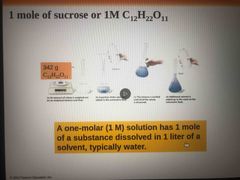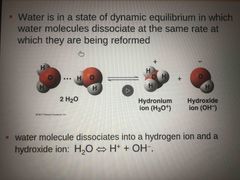![]()
![]()
![]()
Use LEFT and RIGHT arrow keys to navigate between flashcards;
Use UP and DOWN arrow keys to flip the card;
H to show hint;
A reads text to speech;
62 Cards in this Set
- Front
- Back
|
Water |
The molecule that supports all life Only common substance to exist in the natural environment in all three physical states Waters emergent properties help sustain life due to the structure of the water molecule and allowing it to interact with other molecules |
|
|
Water molecule is what type of bond and why |
A polar covalent bond Because oxygens electronegativity creates an uneven distribution of electrons This polarity allows water molecules to form hydrogen bonds with each other |
|
|
Hydrogen bonds of water |
Last briefly Continues to reform over and over Due to polar covalent bonding: high electronegativity |
|
|
4 properties that facilitate an environment for life |
Cohesive behavior Ability to moderate temperature Expansion upon freezing Versatility as a solvent |
|
|
Cohesion |
Hydrogen bonds holding together water molecules Allows the transport of water against gravity Picture a chain of molecules pulling each other up a tree. At the surface of the leaf, it evaporates |
|
|
Adhesion |
The attraction or clinging btw different substances Ex btw water and plant cell walls allows water to travel up the tree defying gravity |
|
|
Surface tension |
Measure of the force needed to stretch or break the surface of a liquid Related to cohesion Water molecules have high surface tension. No bonding of water molecules above them on the surface. Bottom molecules pull downward. Creates a film |
|
|
Heat bank |
Absorbs or released with only a slight change in its own temperature Water moderates air temp by absorbing heat and releasing cooler air |
|
|
Kinetic energy |
Energy or motion Atoms and molecules moving The faster they move the more, the more kinetic energy |
|
|
Thermal energy |
Random motion of atoms or molecules Like shooting pool. One ball hits and releases energy
|
|
|
Heat |
Thermal energy is transferred from one body of matter to another Measure of total quantity of kinetic energy due to molecular motion in a body of matter Think of ice in a drink. The ice absorbs thermal energy from the liquid |
|
|
Temperature |
Measure the intensity of heat in a body due to the avg kinetic energy of the molecules As speed of molecules increases, temp increases Breaking hydrogen bonds increases temperature Heat is Measured by volume vs temp is measuring greater movement of molecules (boiling pot) A swimming pool has more thermal energy bc of its volume |
|
|
When two objects of diff temps come together... |
Heat passes from the warmer to the cooler object Ice cubes cool a glass by absorbing heat from the warmer liquid until they are the same temp |
|
|
Liquid vs freezing |
Higher kinetic energy in liquid held together by weak hydrogen bonds Freezing hydrogen bonds are more stable allowing water molecules far apart |
|
|
A calorie |
The measurement of heat required to raise the temp of water 1g by 1degrees Celsius It is also the amt of heat released when 1g of water releases when it cools by 1 degrees cel. |
|
|
Calories on food packages |
Actual kilocalories 1 kcal = 1,000 cal |
|
|
Joule |
Another unit of energy 1= .239 cal or 1 cal = 4.184 |
|
|
Kilocalorie |
1000 cal Quantity of heat required to raise the temp of 1 kilogram of water by 1 degree Celsius |
|
|
Specific heat |
Amount of heat that must be absorbed or lost for 1 g if that substance to change its temp by 1 degree Celsius Water has a high specific heat It resist changing its temp when it absorbs or release heat Due to hydrogen bonding (hydrogen bonds keep reforming ) |
|
|
Hydrogen bonds and heat |
Heat must be absorbed in order to break hydrogen bonds Hydrogen bonds release a lot of heat when they are formed 1 cal of heat causes little change in temp of water bc much of that energy is used to disrupt hydrogen bonds and not speed up movement of water molecules |
|
|
Hydration shell |
Formed when water molecules surround the individual ions and dissolve them Results in two solutes homogenously mixed Due to water polarity iE:salt dissolved in water. Positive charge hydrogen attract negative anions and negative charge oxygen attract positive cations
|
|
|
Water as a solvent |
Water is a good solvent bc it firms bonds w charged ionic compounds and hydrogen bonds with polar covalent molecules |
|
|
Heat of vaporization |
Heat a liquid must absorb for 1g to be converted to gas Water has a high heat of vaporization: 580 cal to evaporate 1 g of water at room temp Hydrogen bonds must break before water molecule can evaporate |
|
|
Hydrophobic substance |
Does not have an affinity for water Nonionic and have nonpolar covalent bonds Major ingredients of cell membranes IE: oil molecules |
|
|
Solute in aqueous solutions |
Bio Chem is wet chemistry-most chems dissolve in water Chem reactions depend on collisions of molecules n concentrations of solutes in aqueous solutions |
|
|
Molecular (mol) mass |
Sum of all masses of all atoms (atomic mass) in a molecule |
|
|
Mass of a mol |
Is equal to the avg mass of the compound in daltons |
|
|
Concentration |
# of solute molecules in a volume solution |
|
|
Specific heat |
Amount of heat that must be absorbed or lost for 1 g if that substance to change its temp by 1 degree Celsius Water has a high specific heat It resist changing its temp when it absorbs or release heat Due to hydrogen bonding |
|
|
Avogadro number |
Number of molecules in 1 mole 6.02 x 10 to the 23rd One mole of one substances has exactly the same number of molecules of any other substance ie: 1 mole of sucrose =342g, 1 mole of NaCl=58.44g
|
|
|
Molarity (M) |
Number of moles of solute per liter of solution= unit of concentration Concentration of solute in solution 1 mole of a solution= 1 mole of substance dissolved in 1 liter of solvent |
|
|
Hydrogen bonds and heat |
Heat must be absorbed in order to break hydrogen bonds Hydrogen bonds release a lot of heat when they are formed 1 cal of heat causes little change in temp of water bc much of that energy is used to distrust hydrogen bonds and not speed up movement of water molecules |
|
|
Heat of water and earth |
At night and during winter, water heats cooler air Oceans and coastal lands are more stable than inland Living things are made up of water so they can regulate temps better |
|
|
Evaporation/ vapor |
Transformation of liquid to gas Molecules move faster and overcome attraction of other molecules |
|
|
Heat of vaporization |
Heat a liquid must absorb for 1g to be converted to gas Water has a high heat of vaporization: 580 cal to evaporate 1 g at room temp Hydrogen bonds must break before water molecule can evaporate |
|
|
Evaporative cooling |
As a liquid evaporates, it’s remaining surface cools Stabilizes temps in organism and bodies of water Most energetic molecules evaporate leaving lower kinetic molecules behind |
|
|
Floating of ice |
Water is less dense as a solid than as a liquid (ice is 10% less dense and it insulated water below) at 4 degrees Celsius Water expand and more air in between=less denser Each molecule bonded to 4 other molecules Hydrogen bonds are more ordered allowing them to float |
|
|
Solution |
A liquid that is a completely homogeneous mixture of two or more substances (sugar cube in water) |
|
|
Solvent |
Dissolving agent Water is a powerful solvent Most chemical reactions in organisms involve solutes dissolved in water |
|
|
Capillary |
Involving cohesion and adhesion |
|
|
Reversible reaction |
The hydrogen ion Drastically can change the concentrations of H+ and OH- which can affect a cell |
|
|
Acid and basic solutions |
Strong acids and bases dissociate completely in water ( HCL and NaOH
Weak acids and bases reversible release and accept back hydrogen bonds but still shift the balance |
|
|
Concentrations of H+ and OH- |
Con. Equal in water Adding certain solutes (acids and bases) disrupts equilibrium changing the concentrations |
|
|
I mike of sucrose |

Back (Definition) |
|
|
Base |
Any substance that reduces the H+ concentration of a solution NaOH➡️Na+ + OH- |
|
|
pH |
Used to describe whether a solution is acidic or basic pH = potential of hydrogen Started 1909: German potenz meaning power of H |
|
|
Hydrogen ion |

A hydrogen atom in a hydrogen bond btw 2 water molecules can shift from one to the other (1 in 555 million) Hydrogen leaves it’s electron behind and is transferred as a proton creating: A hydrogen ion A hydroxide ion |
|
|
pH unit |
7 is neutral Solution of pH 3 is not twice as acidic as a solution of pH 6 but 1,000 times more acidic |
|
|
pH and body |
Most biological substances are around 6-8 except gastric which is 2 (to break hydrogen bonds) If blood pH goes up or down, could kill organism |
|
|
Buffers |
pH regulatorssssss...mount up Substances that minimize changes in concentrations of H+ and OH- in a solution Most contain a weak acid and it’s corresponding base which combine reversibly with H+ ions |
|
|
Acid and basic solutions |

Strong acids and bases dissociate completely in water ( HCL and NaOH
Weak acids and bases reversible release and accept back hydrogen bonds but still shift the balance |
|
|
Carbonic acid |
Buffer Formed when CO2 reacts with water in blood plasma Dissociates to yield a bicarbonate ion and a hydrogen ion |
|
|
Panting dog |
Water is evaporating from tongue |
|
|
Water is a versatile solvent |
Polar molecules |
|
|
I mike of sucrose |
Back (Definition) |
|
|
1 mole solutions (1M) |
Has 1 mole of a substance dissolved in 1 liter of a solvent Contains 6.02^23 molecules Has a mass equal to its mass # or molecular weight in g |
|
|
Why is it important to know one mole to make solutions |
If you dissolve 1 mole of NaCl which weights 58.44g in 1 liter you made a 1M salt solution You can change this formula to make a 2 M solution by doubling the weight of salt |
|
|
Hydrogen ion |
A hydrogen atom in a hydrogen bond btw 2 water molecules can shift from one to the other (1 in 555 million) Hydrogen leaves it’s electron behind and is transferred as a proton creating: A hydrogen ion A hydroxide ion |
|
|
Hydronium ion |
The molecule with the extra proton (H3O) Represented as H+ |
|
|
Hydroxide ion |
The molecule that lost the proton (OH-) |
|
|
7 elements that are molecules |
Diatomic Hydrogen Nitrogen Oxygen Fluorine Chlorine Bromine Iodine |
|
|
O3 |
Ozone Allotrope of 02 |

